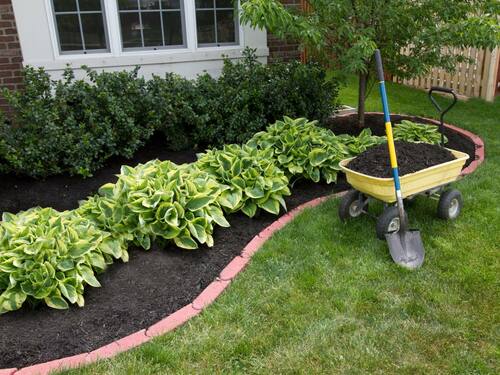Deer-Proofing Your Landscape: A Comprehensive Guide
Introduction
For homeowners in deer-populated areas, maintaining a beautiful landscape can be a constant challenge. These graceful but voracious herbivores can quickly turn your carefully cultivated garden into their personal buffet. This guide will provide you with effective strategies to protect your landscaping from deer damage , ensuring your outdoor space remains beautiful and thriving.
Understanding Deer Behavior
Before diving into prevention methods, it’s crucial to understand deer behavior:
- Feeding Habits: Deer are most active at dawn and dusk.
- Seasonal Changes: Their diet and behavior change with the seasons.
- Adaptability: Deer can quickly learn to overcome simple deterrents.
Deer-Resistant Landscaping Strategies
1. Choosing Deer-resistant Plants
One of the most effective long-term strategies is to landscape with plants that deer find less appealing.
Plants to Avoid

A Garden Bed of Hostas with Fresh Mulch and a Garden Cart
Deer have favorites , and avoiding these can significantly reduce their attraction to your yard:
- Daylilies
- Hostas
- Yews
- Tulips
- Rhododendrons
Deer-resistant Alternatives
Consider these deer-resistant options for your landscape:
- Lavender
- Boxwood
- Ornamental grass
- Butterfly bush
- Russian sage
Pro Tip: No plant is 100 percent deer-proof, but these choices can significantly reduce deer damage.
2. Strategic Plant Placement
How you arrange your plants can also deter deer:
- Border Plants: Use strongly scented or textured plants as a border.
- Vulnerable Plants: Place deer favorites closer to the house or in protected areas.
- Layering: Create depth in your landscape to make it less inviting for deer.
Effective Deer Repellents

A Deer Feeding on Pink Garden Flowers
When plant selection isn’t enough, repellents can provide additional protection.
Commercial Repellents
Many effective commercial repellents are available:
- Spray-on Repellents: Easy to apply but need frequent reapplication.
- Granular Repellents: Longer-lasting but may be less effective in rainy conditions.
- Electronic Repellents: Motion-activated sprinklers or lights can startle deer.
Natural Repellents
For those preferring a more natural approach :
- Homemade Sprays: Mixtures of eggs, garlic, hot peppers, or soap can be effective.
- Strong-smelling Plants: Incorporate herbs like mint, rosemary, or lavender.
- Human Hair: Spreading human hair around your garden can deter deer.
Note: Rotate repellants regularly to prevent deer from becoming accustomed to them.
Landscape Design for Deer Control
Wooden Fence Posts Framed by Autumn Leaves – Image by stevepb on Pixabay
Smart landscape design can significantly reduce deer intrusion.
Fencing Solutions
Fencing is one of the most effective deer deterrents:
- Height: Ideally, fences should be at least eight feet tall.
- Material: Choose between wood, metal, or plastic mesh fencing.
- Design: Consider double fencing or angled fencing for added protection.
Alternative Barriers
When tall fencing isn’t feasible:
- Garden Bed Protection: Use smaller fences (3-4 feet) around specific areas.
- Tree Guards: Protect young trees with cylindrical wire guards.
- Netting: Cover vulnerable plants with fine mesh netting.
Landscaping Tricks
Utilize deer’s poor depth perception to your advantage:
- Terracing: Create multi-level gardens that deer find difficult to navigate.
- Raised Beds: Elevate your garden to make it less accessible.
- Gravel or Stone Pathways: Deer dislike walking on unstable surfaces.
Seasonal Considerations
Deer control needs change with the seasons:
- Spring: Focus on protecting new growth and bulbs.
- Summer: Maintain repellents and barriers as deer seek water-rich plants.
- Fall: Protect fall-blooming plants and consider additional barriers as food becomes scarce.
- Winter: Wrap vulnerable shrubs and continue repellent use if deer pressure is high.
Professional Landscaping Services for Deer Control
While DIY methods can be effective, professional landscaping services offer several advantages:
- Expert Plant Selection: Professionals can design a beautiful, deer-resistant landscape.
- Efficient Installation: Proper installation of fences and other barriers.
- Ongoing Maintenance: Regular upkeep to ensure continued effectiveness.
For those in the San Francisco Bay Area, a local landscaping company can offer specialized services in deer-resistant landscaping. Their experts can help you create a beautiful, low-maintenance landscape that stays protected from deer damage year-round.
Conclusion
Controlling deer in your landscape requires a multi-faceted approach. By combining deer-resistant plant choices, effective repellents, smart landscape design, and seasonal strategies, you can significantly reduce deer damage and enjoy your outdoor space to the fullest. Remember, consistency is key, and what works best may vary depending on your specific location and deer population.
For help selecting and planting deer-resistant trees, contact Arborist Now today and create a beautiful, thriving outdoor space that both you and the local wildlife can coexist with harmoniously.
Originally published on August 24, 2019.



